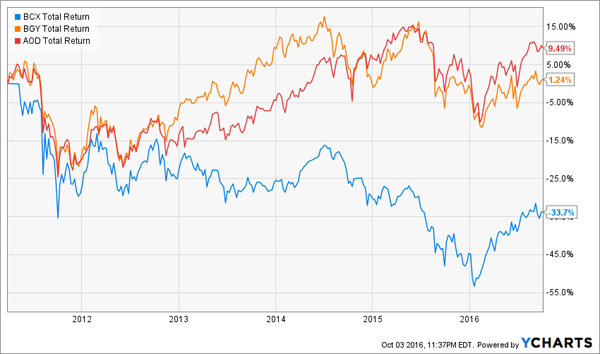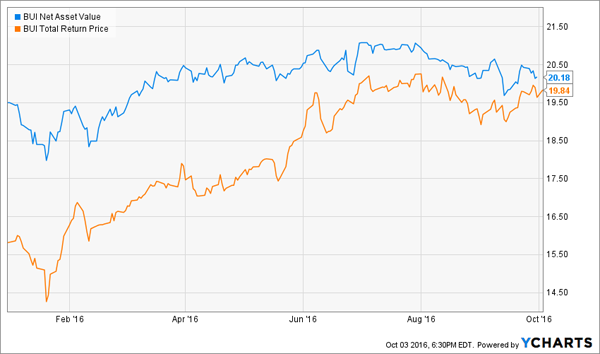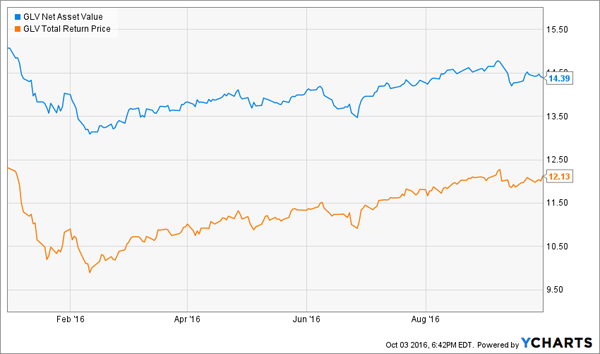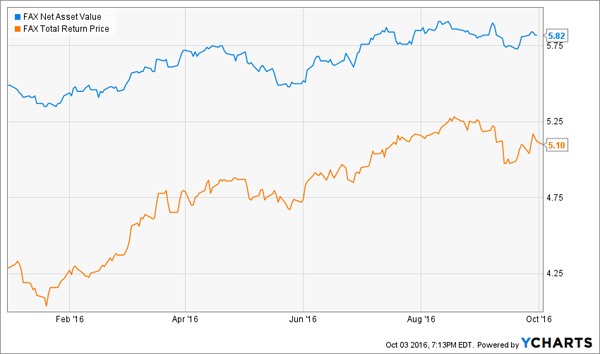Closed-end funds (CEFs) are finally starting to get their due attention as the yield machines they are. Some can still be purchased at a steep discount to their net asset values (NAVs) – which means you can buy the underlying assets for $0.90 on the dollar, or less.
Last week we discussed how to select the safest 7% yields in the field. In a 2% dividend world, many of these funds look great paying more than triple that.
But you’ll need to choose your CEFs carefully. A steep discount is a great start, but many funds simply grind sideways (including dividends) because they have no means to close that discount window.
For example, check out these three popular funds. They trade at 11.5% discounts or better today, but for good reason – they never make their shareholders any money:
Locked in the Discount Dog House

It all depends on how management handles it’s “free money” opportunity. I’ll explain and show you what separates the best funds (a select few) from the worst (the majority).
When Free Money Equals 25% Gains
The BlackRock Utility and Infrastructure Trust (BUI) began the year trading at a steep 19% discount to NAV. That window narrowed as investors flocked to utility stocks and BUI longs banked 25% total returns on a very modest bump in NAV:
25% Total Returns on Just 4% NAV Gains

Seems like a simple formula, right? Buy the 19% discount with the 7% yield and wait for your 25-26% return.
“If only it were always that easy,” Clough Global Dividend and Income (GLV) investors may lament:
Another Discount Window That’s Stuck Open

Cheap closed-end funds are no different from cheap stocks. “Value” investing itself is simply no guarantee of gains. (I suspect you know this, having smartly found your way to dividend paying issues!)
We must also identify a catalyst to propel any price gains. With closed-ends, management teams have two tools available.
A Two-Step Plan for 19% Gains
To kickoff 2016, my Contrarian Income Report subscribers bought the Aberdeen Asia-Pacific Income Fund (FAX). It traded at a 17% discount to NAV and yielded 9%.
FAX was likely to deliver double-digit price gains on top of its big distribution because management had a plan to close the window – and a history of executing.
Since 2001, FAX’s management team has helped its own cause by repurchasing shares when they’ve traded far below NAV. Today, the fund even has ongoing board approval to buy back up to 10% of its outstanding shares of common stock during any 12-month period.
CEF buybacks, when executed at opportune times, are gifts that keep giving. Not only do they help close the window, but they also boost NAV per share as stock is removed from the market.
In addition to repurchases, there’s one more technique FAX’s savvy management team has used successfully. They pay dividends out of existing capital when the window is especially wide.
At a glance, this looks bad. I know many subscribers believe that CEF distributions should always be fully funded from investment income. It sounds like a safe rule of thumb, but it will actually make you miss out on the best opportunities.
For example, as FAX’s discount opened wide, management took advantage of the free money window by paying some dividends from capital. Taken to the extreme, management would simply liquidate all of the fund’s holdings and send distribute 17% gains all around.
But they didn’t want to close the fund – they wanted to reward shareholders and narrow the gap between price and NAV. And they did while boosting NAV in tandem, securing 19% returns for us in just nine months:
It Worked – 19% Returns in 9 Months

Closed-end funds are a cornerstone of my 8% “no withdrawal” retirement strategy, which lets retirees rely entirely on dividend income and leave their principal 100% intact.
Well that’s not exactly right. Their principal is more than 100% intact thanks to price gains like these! Which means principal is actually 110% intact after year 1, and so on.
To do this, I seek out closed-end funds that:
- Pay 6% or 7% or 8% or better…
- Have well funded distributions…
- Trade at meaningful discounts to their NAV…
- And know how to make their shareholders money.
I also talk directly to management often, because online research isn’t enough.
This Friday, I’m recommending a new closed-end fund to my subscribers. It trades at a 13% discount to NAV, pays a 6.5% yield and has outpaced the broader stock market since inception.
That’s an especially impressive feat because it owns safe sovereign bonds. In a world where investors are scrambling for bond proxies, this fund owns secure bonds with price upside to boot thanks to its discount and smart management team!
I’d like to send you the fund name, ticker, buy price and my full analysis this Friday. Please click here to reserve your copy, and learn more about my favorite retirement investing strategy.
